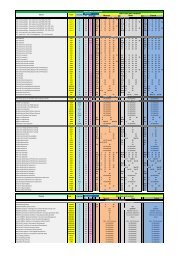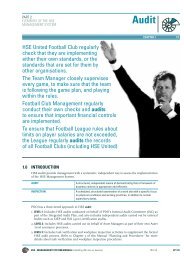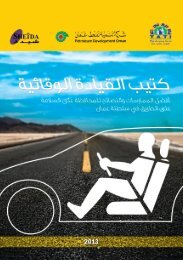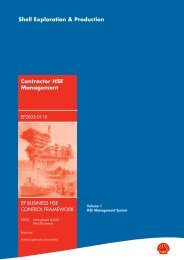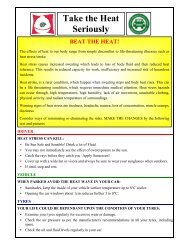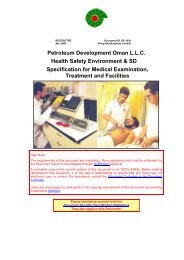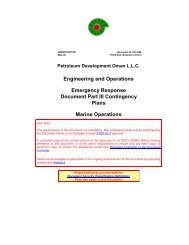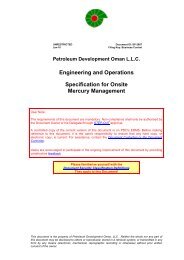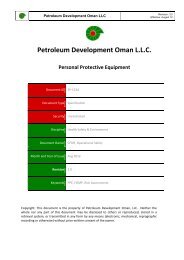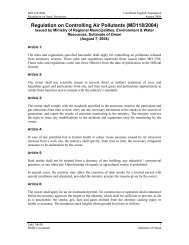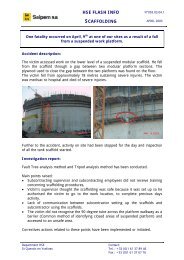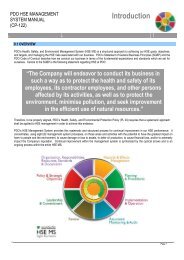Estate Service Asset - PDO
Estate Service Asset - PDO
Estate Service Asset - PDO
You also want an ePaper? Increase the reach of your titles
YUMPU automatically turns print PDFs into web optimized ePapers that Google loves.
Petroleum Development Oman<br />
<strong>Estate</strong> <strong>Service</strong>s <strong>Asset</strong><br />
Environmental Assessment<br />
2002 Review and Update<br />
• Ecology<br />
While some adverse impacts on ecology may be expected from the asset activities, a<br />
few direct beneficial impacts on the ecology also exist. The most significant is the<br />
greening of the desert by re-using treated sewage effluents. The land within the <strong>PDO</strong><br />
main camps and the contractor camps is significantly vegetated with trees, shrubs and<br />
lawns. In addition, <strong>PDO</strong> has developed a large farm in Rahab under “Desert<br />
Agriculture Project” over an area of over 100 ha. The significant vegetal cover<br />
developed in the asset has provided a habitat for the native fauna, most importantly<br />
birds and terrestrial invertebrates.<br />
6.4 Impacts on Natural Resources<br />
The potential environmental effects on the natural resources and the associated<br />
environmental hazards are listed below:<br />
Environmental Hazards<br />
• Consumption of groundwater<br />
Potential Environmental Effects<br />
• Depletion of groundwater resources<br />
Currently, on average about 2200 m 3 /d of groundwater is abstracted continuously<br />
from the Al Khoud well field by estate services for supply to MAF and RAH areas.<br />
Most of this water is consumed for domestic use by <strong>PDO</strong>’s coast based staff. Long<br />
term well monitoring data showed a wide fluctuation of water level over the past 13<br />
years in the range of 7.7 m (1998) to 34.3 m (1994) with reference to the ground level.<br />
The data do not indicate any monotonic decline in the groundwater table from year to<br />
year. Instead, the well water level fluctuated randomly from year to year, apparently<br />
depending on the annual rainfall in the catchment area. Therefore, it appears that<br />
current groundwater abstraction rate is sustainable.<br />
However, the water consumption in the areas serviced by estate services has been<br />
rising steadily over the past five years, except for a marginal decline in year 2000.<br />
Compared to 1997, the water consumption in 2002 increased by about 18%. The<br />
current per-capita domestic water consumption in RAH is estimated to be in the order<br />
of 400 L/d. This is well in excess of WHO recommended per-capita consumption of<br />
250 L/d for comfortable urban living.<br />
Based on the above discussion, the overall impact on groundwater resources is rated<br />
as below:<br />
©HMR Environmental Engineering Consultants C6 - 3<br />
Oman’s Environmental Consultancy<br />
HMR\1501\<strong>Estate</strong> <strong>Service</strong>s



